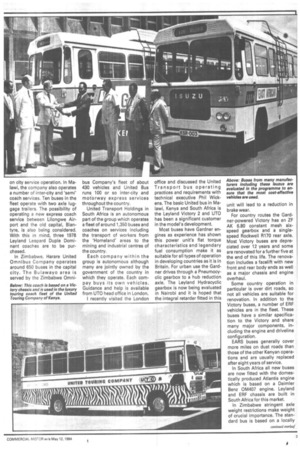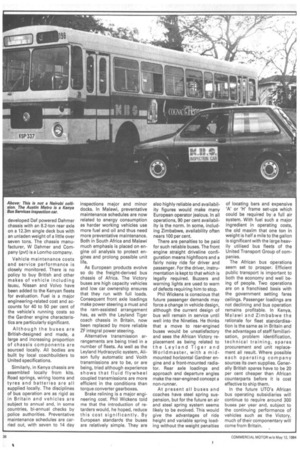British buses ply Africa's dusty routes
Page 36

Page 37

Page 38

If you've noticed an error in this article please click here to report it so we can fix it.
RELIABILITY is the key to successful public transport, so it is not surprising that British Electric Traction's public transport subsidiaries specify buses with that requirement in mind. Many may be surprised to hear of BET in the context of bus operation, as all of the company's bus interests in Britain were taken over and became part of the National Bus Company when that organisation was formed in the Sixties.
BET remains a major bus operator. Its overseas bus operating subsidiaries have become a major export customer for some British manufacturers and a potential customer for foreign rivals.
United Transport Overseas, part of the group, has a number of bus operating subsidiaries in several African countries. In Kenya, Nairobi bus services are successfully meeting the competition from private minibuses. UTO subsidiary Kenya Bus Nairobi has in operation 300 buses including many Leyland Victory 2 vehicles. Kenya Bus Mombasa operates around 80 buses on both urban and country routes. East African Road Services (EARS) operates 70 vehicles on country and inter-urban routes.
United Transport (Malawi) has recently introduced an entirely new route network in the country's new capital city, Lilongwe. With the brand name Cityline, the network uses Leyland Viking based buses with locally assembled bodywork.
Most of United Transport (Malawi) services are country bus routes. Only 20 per cent of its bus fleet, which numbers around 210 vehicles, is engaged on city service operation. In Malawi, the company also operates a number of inter-city and 'semi' coach services. Ten buses in the fleet operate with two axle luggage trailers. The possibility of operating a new express coach service between Lilongwe Airport and the old capital, Blantyre, is also being considered. With this in mind, three 1978 Leyland Leopard Duple Dominant coaches are to be pur chased.
In Zimbabwe, Harare United Omnibus Company operates around 650 buses in the capital city. The Bulawayo area is served by the Zimbabwe Omni bus Company's fleet of about 430 vehicles and United Bus runs, 100 or so inter-city and motorway express services throughout the country.
United Transport Holdings in South Africa is an autonomous part of the group which operates a fleet of around 1,350 buses and coaches on services including the transport of workers from the 'Homeland' areas to the mining and industrial centres of the country.
Each company within the group is autonomous although many are jointly owned by the government of the country in which they operate. Each compay buys its own vehicles. Guidance and help is available from UTO head office in London.
I recently visited the London office and discussed the United Transport bus operating practices and requirements with technical executive Phil Wickens. The basic United bus in Malawi, Kenya and South Africa is the Leyland Victory 2 and UTO has been a significant customer in the model's development.
Most buses have Gardner engines as experience has shown this power unit's flat torque characteristics and legendary fuel consumption make it as suitable for all types of operation in developing countries as it is in Britain. For urban use the Gardner drives through a Pneumocyclic gearbox to a hub reduction axle. The Leyland Hydracyclic gearbox is now being evaluated in Nairobi and it is hoped that the integral retarder fitted in this unit will lead to a reduction in brake wear.
For country routes the Gard ner-powered Victory has an ZF AK 6.80 constant mesh sixspeed gearbox and a single speed Rockwell R170 rear axle. Most Victory buses are depreciated over 12 years and some are renovated for a further five at the end of this life. The renovation includes a facelift with new front and rear body ends as well as a major chassis and engine overhaul.
Some country operation in particular is over dirt roads, so not all vehicles are suitable for renovation. In addition to the Victory buses, a number of ERF vehicles are in the fleet. These buses have a similar specification to the Victory and share many major components, including the engine and driveline configuration.
EARS buses generally cover more miles on dust roads than those of the other Kenyan operations and are usually replaced after eight years of service.
In South Africa all new buses are now fitted with the domestically produced Atlantis engine which is based on a Daimler Benz 0M407 engine. Leyland and ERF chassis are built in South Africa for this market.
In Zimbabwe stringent axle weight restrictions make weight of crucial importance. The standard bus is based on a locally developed Daf powered Dahmer chassis with an 8.2-ton rear axle on a 12.3m single deck bus with an unladen weight of a little over seven tons. The chassis manufacturer, W Dahmer and Company (pvt) is a Lonrho company.
Vehicle maintenance costs and service performance is closely monitored. There is no policy to buy British and other makes of vehicle including lsusu, Nissan and Volvo have been added to the Kenyan fleets for evaluation. Fuel is a major engineering-related cost and accounts for 40 to 50 per cent of the vehicle's running costs so the Gardner engine characteristics are particularly significant.
Although the buses are British-designed and made, a large and increasing proportion of chassis components are sourced locally. All bodies are built by local coachbuilders to United specifications.
Similarly, in Kenya chassis are assembled locally from kits. Road springs, wiring looms and tyres and batteries are all supplied locally. The disciplines of bus operation are as rigid as in Britain and vehicles are subject to annual and, in some countries, bi-annual checks by police authorities. Preventative maintenance schedules are carried out, with seven to 14 day inspections major and minor docks. In Malawi, preventative maintenance schedules are now related to energy consumption as harder working vehicles use more fuel and oil and thus need more preventative maintenance. Both in South Africa and Malawi much emphasis is placed on engine oil analysis to protect engines and prolong possible unit life.
As European products evolve so do the freight-derived bus chassis of Africa. The Victory buses are high capacity vehicles and low car ownership ensures that they run with full loads. Consequent front axle loadings make power steering a must and the ram-assisted arrangement has, as with the Leyland Tiger coach chassis in Britain, now been replaced by more reliable ZF integral power steering.
Alternative transmission arrangements are being tried in a number of fleets. As well as the Leyland Hydracyclic system, Alison fully automatic and Voith transmissions are to be, or are being, tried although experience shows that fluid flywheel coupled transmissions are more efficient in the conditions than torque converter gearboxes.
Brake relining is a major engineering cost. Phil Wickens told me that the introduction of retarders would, he hoped, reduce this cost significantly. By European standards the buses are relatively simple. They are also highly reliable and availability figures would make many European operator jealous. In all operations, 90 per cent availability is the norm. In some, including Zimbabwe, availability often nears 100 per cent.
There are penalties to be paid for such reliable buses. The front engine straight driveline configuration means highfloors and a fairly noisy ride for driver and passenger. For the driver, instrumentation is kept to that which is legally required. Buzzers and warning lights are used to warn of defects requiring him to stop.
Phil Wickens is conscious that future passenger demands may force a change in vehicle design, although the current design of bus will remain in service until well into the Nineties. He thinks that a move to rear-engined buses would be unsatisfactory and sees the African Victory replacement as being related to the Leyland Tiger and Worldmaster, with a midmounted horizontal Gardner engine and a front-mounted radiator. Rear axle loadings and approach and departure angles make the rear-engined concept a non-runner.
At present all buses and coaches have steel spring suspension, but for the future an air and steel spring system seems likely to be evolved. This would give the advantages of ride height and variable spring loading without the weight penalties of locating bars and expensive 'A' or 'H' frame set-ups which could be required by a full air system. With fuel such a major ingredient in operating costs, the old maxim that one ton in weight is half a mile to the gallon is significant with the large heavily utilised bus fleets of the United Transport Group of companies.
The African bus operations seem set to prosper. Efficient public transport is important to both the economy and well being of people. Two operations are on a franchised basis with the government setting fares ceilings. Passenger loadings are not declining and bus operation remains profitable. In Kenya, Malawi and Zimbabwe the rationale for fleet standardisation is the same as in Britain and the advantages of staff familiarisation, problem identification, technical training, spares procurement and unit replacement all result. Where possible each operating company sources its own supplies. Generally British spares have to be 20 per cent cheaper than African counterparts before it is cost effective to ship them.
In the future UTO's African bus operating subsidiaries will continue to require around 300 buses per year and, subject to the continuing performance of vehicles such as the Victory, much of their componentary will come from Britain.












































































































